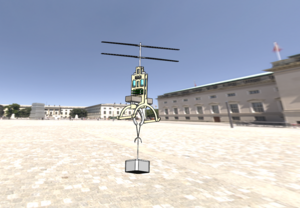
This design challenge aims to explore the possibility of developing unmanned flying vehicles (drones) capable of aiding in emergency operations when the use of human power is impossible or undesirable. Previous design efforts have been attempted to solve this problem. The 2019-2020 OSU Micro Air Vehicle team attempted to create a coaxial rotor MAV design.
The coaxial rotor design has some desirable characteristics owing to its rotor orientation. Because the rotors are rotating about the same axis in opposite directions, equal and opposite torque moments are applied to the airframe which effectively cancel one another out for a net zero overall torque. To accomplish this, however, rotors of equal size and mass must rotate at an equal rate but opposite direction. This concept, while seemingly simple, is mechanically difficult to execute. Previous OSU team attempts at this design were unable to achieve equal and opposite rotations for the rotors and thus were not able to achieve stable flight due to the excessive torque induced on the airframe. Had this problem been overcome, the design may have proven effective.
After researching other methods for synchronizing rotor rotation we discovered that many designs utilize a mechanical gear drive that converts the rotation of a single input shaft into the equal but opposite rotations of the coaxial output shafts. Although this mechanical drive system is sound in principle, it is mechanically quite complicated. A single input shaft requires a complex system of swash plates and linkages in order to provide adequate control of the pitch, roll, and yaw of the aircraft.
Given that our design is on a smaller scale, it was not be possible to utilize a mechanism as complex as the gear drive transmission. Instead, the current design utilizes two separate motors, one turning each rotor, varying rotational speed in order to give control of the yaw of the aircraft. For control over the pitch and roll of the aircraft, a single swash plate is attached to the bottom rotor. This reduces the amount of mechanical linkage needed to provide control over necessary flight functions.
The team gained valuable experience that is expected to advance qualifications leading to gainful employment in related industries. We also worked to advance a prestigious engineering program and gathered knowledge upon which future engineering students can build. One of the primary professional gains for team members came from learning first-hand all that is entailed in developing and executing a conceptual design from beginning to end. The team is divided into sub-teams (i.e., mechanical engineering, electrical engineering, computer science), each of which focused on an aspect of the design fitted to their area of expertise.
-
The mechanical engineering team will handled the flight mechanics and the design of the airframe.
-
The electrical engineering team designed the power management system as well as the specifications of the required electrical components.
-
The computer science team designed the user interface that allows for both the control and monitoring of the MAV and analytical output.
